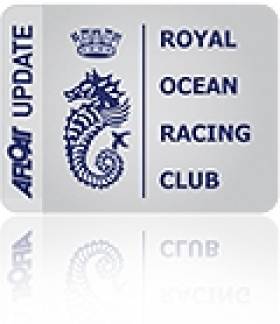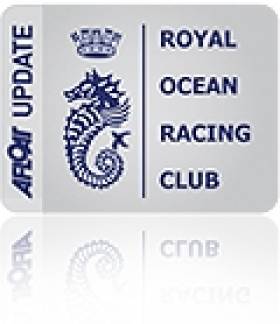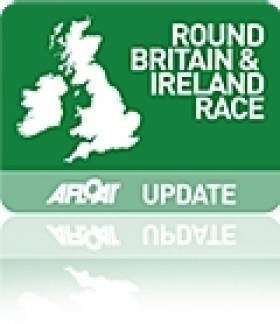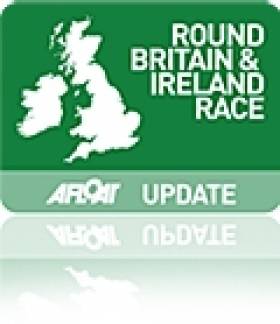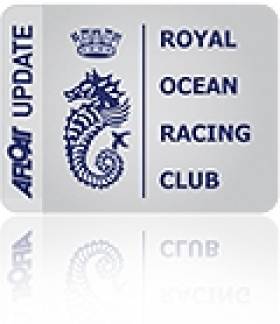Displaying items by tag: Piet Vroon
2010 Round Ireland Race winner Piet Vroon's custom Ker 46, Tonnerre de Breskens, returns to RORC racing after winning her class at this year's RORC Caribbean 600. The sky blue flyer, which was RORC Yacht of the Year for 2010, has undergone some rig and sail modifications in Breskens before arriving in Hamble this week to continue their racing programme, leading up to the Rolex Fastnet Race this August.
Chaz Ivill's Grand Soleil 54, John B, won IRC One in last month's Cervantes Trophy Race. "John B will be competing in six RORC races this year, including the Rolex Fastnet Race," explained Chaz Ivill. "Competing in the De Guingand Bowl is just part of this year's offshore program. The core crew has been very successful and has been together for five years, this will be our third Fastnet campaign on the trot. However, John B has a blend of youth and experience and we have three sailors new to offshore sailing. Sam Cooper is just 18 and a student, Nathan Hanley is 22 and a sailmaker and Matt Mills has just finished University and is the son of regular crew, Tim Mills. Also William Broughton will be joining us this week for his first race on John B, William is eighteen and studying at Plymouth University."
RORC Commodore Andrew McIrvine's First 40, La Réponse, won class in the Cervantes Trophy Race. McIrvine's crew are all friends with no professionals on board. "Jason Owen will be the skipper for the De Guingand Bowl Race, fresh from winning the Etchells Class in Bermuda," commented Andrew. "Jason is highly experienced but not all of the crew are; Tame Welsh has done very little sailing but has rowed across the Atlantic and Indian Oceans and is also a PhD nurse." McIrvine's La Réponse can expect a close battle with another First 40, Guy Prest's Tarka II of Hamble, which should provide a close duel. Neil Kipling's J/122, Joopster, is also in fine form.
IRC Two also contains several First 40.7s, including Trevor Drew's Blue Juice, representing the Civil Service Offshore Racing Club.
"The CSORC has a long history as a club, with one of its first races being the 1979 Fastnet," explained Trevor Drew. "The emphasis is on having fun, with a friendly atmosphere. There is no minimum level of experience to sail with the club but the offshore crew has now completed the RYA Sea Survival and the ISAF Offshore Safety Course. We've been out on Blue Juice, getting in some team practice in the Solent and offshore. Our aim is to learn as much as we can and hopefully winning will come later."
Two-handed racing is becoming an extremely popular discipline within the RORC Season's Points Championship and fourteen yachts will be competing this weekend. Racing short-handed requires an all-round sailing ability and the class attracts a wide variety of people.
Kirsteen Donaldson and Judith Eastwood make up the all-girls team on X 332, Pyxis. Between them they have racked up thousands of sea miles including races from The Solent to La Trinité and Santander but Kirsteen is happy that the De Guingand Bowl Race will finish in the Solent.
"Previously, I would have preferred races that could be used as a feeder for a holiday. However, my sailing partner's husband is not keen on sailing and my 'other half' is not keen on long passages home, so finishing near where we started allows us to get a good sail into a weekend most diplomatically!"
Frederic Waniart and crew are the two-handed team in form, having won the Cervantes Trophy Race last time out. Vim is one of the oldest boats competing but has been meticulously prepared by the French team. The legendary Paul Elvström designed the Aphrodite 101 in 1977.
"We will be racing the De Guingand double handed, as part of our season racing with RORC and also the UNCL double handed series," explained Frederic Waniart. "One lawyer and one surgeon who have been sailing friends for quite some time. As for experience, it is my fourth season with the RORC in double handed sailing. I love racing with the RORC because there is a real competition, and the courses are very well organised."
The Royal Ocean Racing Club's Season's Points Championship consists of a testing series of races, which attracts an international and varied fleet. For the serious offshore sailor, trying to win the Season's Points Championship is a real challenge. The Season's Points Championship this year includes the tactically and physically challenging Rolex Fastnet Race, the oldest and most prestigious offshore yacht race in the world.
Round Ireland Winner is RORC's Yacht of the Year
The Royal Ocean Racing Club in London announced that Holland's Piet Vroon's Ker 46 Tonnerre de Breskens 3 is the 2010 Yacht of the Year.
Piet has been racing with the RORC for 50 years and during that time has achieved many notable successes including winning the Rolex Fastnet Race. Now 80 years young, he competed in eight RORC races this season including the Conway Media Wicklow's Round Ireland and the Sevenstar Round Britain and Ireland Race.
Tonnerre de Breskens 3 takes the Jazz Trophy for the overall winner of the Season's Points Championship (when all races count); the Trenchemer Cup for winning IRC Zero; the Stradivarius Trophy for the best overseas yacht in IRC and also the Somerset Memorial Trophy for outstanding racing achievement by a yacht owned or sailed by a RORC member as voted for by the Main Committee. It was a spectacular season from a veteran campaigner and great supporter of RORC racing.
Niklas Zenstrom's JV72, Rán 2, was awarded the Dennis P Miller Memorial Trophy for a British Yacht Overseas. Rán travelled all over the world and has an impressive list of victories which included the Mini-Maxi Rolex World Championships, winning her divisions in the 2009 Rolex Sydney Hobart Race; Antigua Sailing Week; Newport Bermuda Race; Onion Patch Series and Copa del Rey.
Also of note are the team on British Soldier who were second overall in the Season's Points Championships and won the Serendip Trophy for the best series produced yacht in IRC. The boat provides much needed 'R and R' for war veterans and through the Toe in the Water tri-services initiative, introduces many disabled servicemen to sailing.
A full list of all the RORC trophy and award winners:
RORC Annual Challenge Trophies and Special Awards
2010 YACHT OF THE YEAR - TONNERRE DE BRESKENS 3 (KER 46) PIET VROON
Winning the SOMERSET MEMORIAL TROPHY
For outstanding racing achievement by a yacht owned or sailed by a RORC member as voted for by the Main Committee.
In recognition of not only winning IRC Overall by a huge margin, but in particular for supporting and winning RORC races for over 50 years.
ASSUAGE TROPHY - FOGGY DEW (JPK 10.10) NOEL RACINE
CHAMPIONSHIP FOR RORC MEMBERS
For the yacht with the most points in IRC overall in the Cherbourg Race plus her best three races taken from Cervantes, Morgan Cup, Myth of Malham and Cowes-Dinard-St. Malo races
ALAN PAUL TROPHY - BRITISH SOLDIER (A 40) ARMY SAILING ASSOCIATION, LT COL TIM HILL
For consistent high performance in IRC. Based on consistent high scores plus a bonus for number of races completed.
Class Championship Tropies
| IRC Overall | Jazz Trophy | Tonnerre de Breskens 3 (Ker 46) | Piet Vroon |
|---|---|---|---|
| IRC Super Zero | Europeans Trophy | John Merricks II (TP 52) | British Keelboat Academy |
| IRC Zero | Trenchemer Cup | Tonnerre de Breskens 3 (Ker 46) | Piet Vroon |
| IRC One | Emily Verger Plate | Visit Malta Puma (Reflex 38) | Sailing Logic, Philippe Falle |
| IRC Two | Grenade Goblet | Foggy Dew (JPK 10.10) | Noel Racine |
| IRC Three | Cowland Trophy | Iromiguy (Nicholson 33) | Jean Yves Chateau |
| Two-Handed Division | Psipsina Trophy | Psipsina (HOD 35) | John Loden & Patrick Cronin |
| David Fayle Memorial Cup | For the best Sailing School Yacht in IRC | Visit Malta Puma (Reflex 38) | Sailing Logic, Philippe Falle |
|---|---|---|---|
| Haylock Cup | For the best British Service Yacht in IRC | British Soldier (A40) | Army Sailing Association, Lt Col Tim Hill |
| Stradivarius Trophy | For the best Overseas Yacht in IRC | Tonnerre de Breskens 3 (Ker 46) | Piet Vroon |
| Serendip Trophy | For the best Series-produced Yacht in IRC | British Soldier (A40) | Army Sailing Association, Lt Col Tim Hill |
Special Awards
| Freddie Morgan Cup | For a Classic Yacht in IRC | Winsome (S&S 41) | Harry Heijst |
|---|---|---|---|
| Dennis P Miller Memorial Trophy | For a British Yacht Overseas | Rán 2 (JV 72) | Niklas Zennström |
| Arambalza Swan Cup | For the highest scoring Swan in the race season | Selene (Swan 44) | Adrian Lower |
| Peter Harrison Youth Trophy | John Merricks II (TP 52) | British Keelboat Academy | |
| Duncan Munro-Kerr Youth Challenge Trophy | For the youngest crew member on board a yacht which on Season's Points finishes in the top three of her IRC Class |
Floris R. W. Oud sailing on Winsome | |
| Red Funnel Prix D'Elegance | Antix (Ker 39) | Anthony O'Leary | |
| RORC Salver | Morgan Cup Race - First Yacht Home | Tonnerre de Breskens 3 (Ker 46) | Piet Vroon |
2010 RORC Points Championship
RORC Medallions: Gold – 1st, Silver – 2nd, Bronze – 3rd, 4th & 5th
| IRC Super Zero | ||
|---|---|---|
| 1st | John Merricks II (TP 52) | British Keelboat Academy |
| IRC Zero | ||
| 1st | Tonnerre de Breskens 3 (Ker 46) | Piet Vroon |
| 2nd | John B (Grand Soleil 54) | Charles Ivill |
| 3rd | Erivale III (Ker 39) | Mike Greville |
| IRC One | ||
| 1st | Visit Malta Puma (Reflex 38) | Sailing Logic, Philippe Falle |
| 2nd | British Soldier (A 40) | Army Sailing Association, Lt Col Tim Hill |
| 3rd | Coup de Coeur (First 40) | Marc de Saint Denis & Géry Trentesaux |
| IRC Two | ||
| 1st | Foggy Dew (JPK 10.10) | Noel Racine |
| 2nd | Psipsina (HOD 35) | John Loden & Patrick Cronin |
| 3rd | Winsome (S&S 41) | Harry Heijst |
| IRC Three | ||
| 1st | Iromiguy (Nicholson 33) | Jean Yves Chateau |
| 2nd | Ultreia! (JPK 9.60) | Matthias Kracht |
| 3rd | Pyxis (X 332) | Kirsteen Donaldson & Judith Eastwood |
| Two-Handed Division | ||
| 1st | Psipsina (HOD 35) | John Loden & Patrick Cronin |
| 2nd | Solan Goose of Hamble (A 35) | Peter Olden |
| 3rd | Diablo-J (J 105) | Nick Martin |
| Class 40 Division | ||
| 1st | Concise 2 | Ned Collier Wakefield |
| 2nd | Orca | Tom Hayhoe & Natalie Jobling |
| 3rd | Merena | Alexis Guillaume |
| IRC Overall |
||
|---|---|---|
| 1st | Tonnerre de Breskens 3 (Ker 46) | Piet Vroon |
| 2nd | British Soldier (A 40) | Army Sailing Association, Lt Col Tim Hill |
| 3rd | Visit Malta Puma (Reflex 38) | Sailing Logic, Philippe Falle |
| 4th | Psipsina (HOD 35) | John Loden & Patrick Cronin |
| 5th | John Merricks II (TP 52) | British Keelboat Academy |
| Assuage Tankards |
||
|---|---|---|
| Cervantes Trophy Race | Visit Malta Puma (Reflex 38) | Sailing Logic, Philippe Falle |
| Myth of Malham Race | Tonnerre de Breskens 3 (Ker 46) | Piet Vroon |
| Morgan Cup Race | Psipsina (HOD 35) | John Loden & Patrick Cronin |
| Cowes-Dinard-St. Malo Race | John Merricks II (TP 52) | British Keelboat Academy |
Tonnerre Narrowly Misses Out on Round Britain and Ireland Win
At just before 2 a.m. this morning, The British Keelboat Academy's TP52, John Merricks II crossed the Royal Yacht Squadron Line to finish the Sevenstar Round Britain and Ireland Race. The 14 young crew on board should have taken a bow, but instead they were organising packing up the boat and plan to be back competing in the RORC offshore race to Cherbourg on Friday. Completing this tough and challenging yacht race in a boat that was not constructed for that purpose is some achievement and the John Merricks II crew should be highly regarded for their impeccable boat handling.
"This has been and always was going to be the highlight of our season. It is what we have all been building up for," commented skipper, Luke McCarthy." The crew all performed magnificently and have taken a big step-up in terms of their capabilities and skill levels. Beating up the North Sea was very hard on the crew and the boat, but apart from a few bumps and bruises, the crew and the boat are in good shape. We made a few mistakes which cost us, but the important thing is that we have made leaps and bounds as a crew and we intend to go on from here. I have no doubt that some of the crew will go on to compete at the highest level in offshore racing and I would not be surprised to see some taking part in the Volvo Ocean Race next year."
John Merricks II is second in IRC Super Zero and currently fourth in IRC overall. Crew members Sally Olsen from Devon and Becky Scott from Scotland are the first two girls to complete thisyears race.
Less than two hours later than John Merricks II, Piet Vroon's Ker 46, Tonnerre de Breskens came through the line at pace under spinnaker. In a great show of sportsmanship, John Merricks II cheered Tonnerre de Breskens in. On board were many of their friends and seven of the 11 crew racing Tonnerre de Breskens are under 28 years of age. On the other hand, Piet Vroon is now in his 81st year. Vroon is a previous winner of this race and a veteran of more than 25 Fastnet Races as well as countless RORC offshore races. He has more experience in yacht racing than anyone in the entire fleet. Dockside, Piet Vroon commented:
"Obviously it is disappointing not to win, but we can do nothing about the wind, no-one can. It is has been a fantastic race. I will always remember flying down the west coast of Ireland under spinnaker for a whole day and a whole night. We had our problems, just like everyone else did, but when we had no gas to cook with, we still had food and cold coffee. We didn't go hungry and when the motion of the boat was so bad that we couldn't stand up, we still did our jobs. Everybody has problems, they are not the concern, solving them is. This race is a long one, but once you have spent a few days at sea, a few more doesn't matter so much. I have to say, when we were passing Aberdeen beating up the North Sea, I did think about the nice office I have there and the coffee machine! But, I can only remember retiring from two races; once for my mother's funeral and the second, a Fastnet race when we were dismasted."
Piet Vroon is obviously a man who doesn't give up.
This race has been full of record breakers and the next yacht to finish the Sevenstar Round Britain and Ireland Race should be Tony Lawson's Class 40, Concise skippered by Tom Gall. At 1000 BST, Concise were 114 miles out and expected to finish tomorrow morning. They are currently experiencing very unusual light easterly winds but there will be a big celebration for the young crew. They should be well inside, Michel Kleinjans' Roaring Forty, whose record time of 11 Days 12 hours 26 minutes and 12 seconds has stood for six years.
At 1000 BST, Eike Holst's Andrews 56, Norddeutsche Vermögen Hamburg had 151 miles to go. The German yacht should finish tomorrow assuming that the light winds hold out. As a result of the high-pressure system that is situated over central England, the remainder of the fleet is a substantial distance further back on the race course.
In IRC One, Steven Anderson's First 40.7 Encore, has a substantial lead. In IRC Two, Winsome still hold the advantage over close rival Selene. However Selene has made a move to the west of the rhumb line which will be interesting to see how they fare. It will be a long haul for the boats at the back of the fleet. At 1000 BST, The Army Sailing Association's A 40, British Soldier was off the Tearaght Islands on the stunningly beautiful south west coast of Ireland. British Soldier had 457 miles to go but they obviously haven't lost their sense of humour. As skipper, Tim Hill explains in his blog:
"Life remains on board relatively sane. No major concerns with regards to rations, gas or water, although some interesting combinations are beginning to appear which weren't listed on the original victualling plan. We're out of Tabasco (although Paul, the 1st Mate keeps producing his own reserve which looks decidedly like our missing spare bottle); coffee has been rationed to the over 28s (that's the skipper and 1st mate only) and if we don't get in before Friday, then it's Vesta curry for breakfast, lunch and supper on Sat and Sun - nice!
Jonny Malbon's IMOCA 60 Artemis Ocean Racing is still leading the Sevenstar Round Britain & Ireland overall under IRC.
No Irish for Record Breaking Round Britain and Ireland Race
Although there is a record fleet for the Sevenstar Round Britain and Ireland race there is no Irish entry for what is one of the most challenging races in the world. For the 2010 edition, more competitors than ever will be racing around Great Britain, Ireland and all of the outlying islands. Irish fans will have to make do with supporting June's Round Ireland Race winner, Tonnerre de Breskens 3, Piet Vroon's Ker 46 when the race starts in seven days time.
The non-stop race has 29 entries and has attracted a diverse range of ocean-going yachts, with world-class professional teams rubbing shoulders with corinthian crews. They all have one thing in common: to take on this iconic race and everything that mother nature can throw at them.
Nine Nations Compete
Yachts flying the ensigns of Austria, Britain, France, Germany, Holland, Italy, Lithuania, Spain and Sweden will cross the Royal Yacht Squadron start line off Cowes, Isle of Wight on Monday 23rd August. The course takes them through a myriad of different conditions and crews will have to cope with a huge number of elements which make this race just so compelling.
RORC CEO, Eddie Warden Owen explains: "Crews will face the vagaries of the tides and unpredictable weather; dodging oil rigs and container ships as well as relying on tactical and navigational decisions and great seamanship to get them round the course! Most sailors agree that this race is one of the toughest tests as it is nearly as long as an Atlantic crossing, but the changes of direction at headlands will mean constant breaks in the watch system for sail changes and sail trim."
Course record breaker on ICAP Leopard
The out and out favourite for line honours and perhaps a course record, is Mike Slade's 100ft Maxi, ICAP Leopard who will also have previous course record holder, Sam Davies on board. Slade is sure to have a set of numbers duct-taped to the navigation station: 06:11:30:53 - the current course record which was set in 2009 by Sam Davies and Dee Caffari in Dee's Open 60, Aviva.
Round the World Sailors Volvo 70 duel
It has been over a year since the finish of the 2008-09 Volvo Ocean Race and the Sevenstar Round Britain and Ireland Race sees the return of two canting keel Volvo 70s to the racing arena. There is the mouthwatering prospect of Groupama locking horns with Telefonica Azul for a duel, which could well go to the wire. Both teams will be racing around the world in October 2011 and this is the first time the two teams have done battle together. Jules Verne winner, Frank Cammas, skippers Groupama. His opposite number on Telefonica Azul is Iker Martinez and the crew on both boats reads like a 'who's who' of round the world sailors, including Neal MacDonald, who will be racing on Telefonica Azul:
"I have very fond memories of the race," commented Neal MacDonald who first competed on Sticky Fingers in 1994. "I had a fantastic time, great sailing on a good boat with a fun crew. The race course is shorter than say an Atlantic crossing, but can be a lot tougher and often far more complex. The main reason it is so much harder is that there are so many corners to go round, each one normally associated with a change of weather conditions. Lots of tacks and gybes, lots of sail changes and a massive variety of weather conditions. For the entire race, it is impossible to get into a proper routine or watch system. It is a rewarding but very tiring race. It is always a pleasure to sail in home waters but to sail round your home country is fantastic, a real experience. I'm very much looking forward to it. It will also be a proper race with some great competition. All in all it has the makings of a terrific race."
Corinthian Entries
Whilst the bigger boats may be crewed by seasoned professionals, there are many corinthian entries in the race. Adrian Lower is a gynaecologist and father of three and will be racing the Swan 44 Selene under the burgee of the Royal Burnham Yacht Club: "I have put together a great team of East Coast sailors and we look forward to the challenge. Our sights are set particularly on Winsome, another Sparkman and Stephens design from the 1970's. She is extremely well sailed and their team has sailed together for a number of years. Winsome has been our benchmark in the 2009 Rolex Fastnet and North Sea Race this year.
Spectators can follow the race as each boat is supplied with an OCTracker beacon. Synchronised position reports will be displayed graphically at regular intervals on the race website. The media and general public are able to see at a glance the relative positions of all boats in the fleet and where they stand on handicap. The competitors will also be sending messages, pictures and videos of their adventures, which will be screened, on the main event web site: http://sevenstar.rorc.org/.
Following the success of the Virtual Fastnet Race last year, when 27,000 players entered online, the Royal Ocean Racing Cub is working with online race experts Virtual Regatta to provide a virtual race round the British Isles for the Sevenstar Round Britain and Ireland Race. Armchair experts around the world can test their skills against the sailors racing on the yachts. The course will mirror the 1802 n mile race which tests inshore and offshore skills, preparation and speed potential. The virtual race will be no different! Sign up via the website: (http://sevenstar.rorc.org/).
Entries for the Sevenstar Round Britain and Ireland Race 2010:
Flag Boat Name Owner/Skipper Design
1 SWE Alicia Jonas Sandberg First 50
2 LTU Ambersail Simonas Steponavicius VO60
3 NED Arethusa Cornelis Mijs J 109
4 GBR Artemis Ocean Racing Andrew Tourell IMOCA 60
5 NED Beluga Floris Ingen Housz Baltic 45
6 GBR British Soldier Army Sailing Assoc/Tim Hill A 40
7 AUT Celox 40 Gottfried Pössl Class 40
8 GBR Change of Course Keith Gibbs C & C 115
9 GBR Cheeki Rafiki Stormforce Coaching/Doug Innes First 40.7
10 GBR Concise 2 Tony Lawson/Tom Gall Class 40
11 GBR Hull and Humber Clipper Ventures Clipper 68
12 GBR Edinburgh Inspiring City Clipper Ventures Clipper 68
13 GBR Encore Steven Anderson First 40.7
14 GBR Fair Do's VII John Shepherd Ker 46
15 FRA Groupama Franck Cammas Volvo Open 70
16 ITA In Direzione Ostinata E Contraria Luca Zoccoli Ostar 35
17 GBR John B Charles Ivill Grand Soleil 54
18 GBR John Merricks II British Keelboat Academy/Luke McCarthy TP 52
19 GBR ICAP Leopard Mike Slade Maxi 100
20 GER Norddeutsche Vermögen Hamburg Hamburgische Verein Seefahrt e.V. Andrews 56
21 GBR Playing Around Logic Sailing Logic/Peter Robson First 40.7
22 GBR Relentless on Incisor Chris Radford/James George Corby 45
23 GBR Selene Adrian Lower Swan 44
24 GBR Sonic Boom II Simon Brady Figaro II
25 ESP Telefónica Azul Equipo Telefonica / Iker Martinez Volvo Open 70
26 NED Tonnerre de Breskens 3 Piet Vroon Ker 46
27 FRA Vecteur Plus Nicolas Groleau Mach 45
28 GBR Visit Malta Puma Sailing Logic/Philippe Falle Reflex 38
29 NED Winsome Harry Heijst S&S 41
Round Ireland Winner Vroon Starts as Channel Race Favourite
Round Ireland Race Winner Piet Vroon’s Tonnerre de Breskens 3, who is leading the Season’s Points Championship by a country mile, starts as favourite for RORC's Channel Race in nine days time. It is the last RORC offshore race prior to the Sevenstar Round Britain and Ireland Race and some well known boats will be competing in the race which will last between 24-36 hours on a flexi-course. The top boat under IRC will win the Channel Challenge Cup and there are plenty of contenders.
In IRC Super Zero Derek Saunders’ CM 60, Venomous, will be hoping for strong winds to propel him to victory but John Merricks II are on a roll having just won the Cowes Dinard St Malo race and will be hard to beat.
Piet Vroon’s Tonnerre de Breskens 3, who is leading the Season’s Points Championship by a country mile, is back after winning the Round Ireland Race earlier this month. However John Shepherd’s Fair Do’s VII, Chris Radford’s Relentless on Incisor and Charles Ivill’s John B will also be looking for a good result in IRC Zero. All of these boats go head to head in IRC Zero for this race and the 1760 mile Sevenstar Round Britain and Ireland Race next month.
Scratch boat in IRC One is Neil Kipling’s J 122, Joopster, and they have some well known competition including RORC Commodore Andrew McIrvine and Peter Morton’s First 40, La Réponse. Andrew McIrvine is a seasoned offshore sailor and will also be campaigning his First 40 in this year’s Rolex Commodores’ Cup. He had this to say prior to the Channel Race: “Many of the entries are using this race as a pre-cursor to the Sevenstar Round Britain and Ireland Race, the biggest offshore race in the club’s calendar this year. It is a long hard race, last time out the boats beat nearly the whole way around the 1760 mile course; it tests the metal of everyone.”
The Army Sailing Association’s A 40, British Soldier, and Sailing Logic’s Reflex 38, Visit Malta Puma, are fighting it out to lead IRC One in the Season’s Points Championship and will both race round Britain and Ireland.
The top of IRC Two is dominated by two handed boats. In the Channel Race John Loden’s Psipsina and Peter Olden’s Solan Goose of Hamble will be looking for more success in the competitive class.
All three boats in IRC Three are at the top of the leader board. Matthias Kracht’s Ultreia! the Phoenix Yacht Club’s Spellbinder of Wytch, and Jean Yves Chateau’s Iromiguy are sure to have a close battle.
The Race Committee will decide the course the day before the start which will be designed to suit the prevailing wind conditions.





























